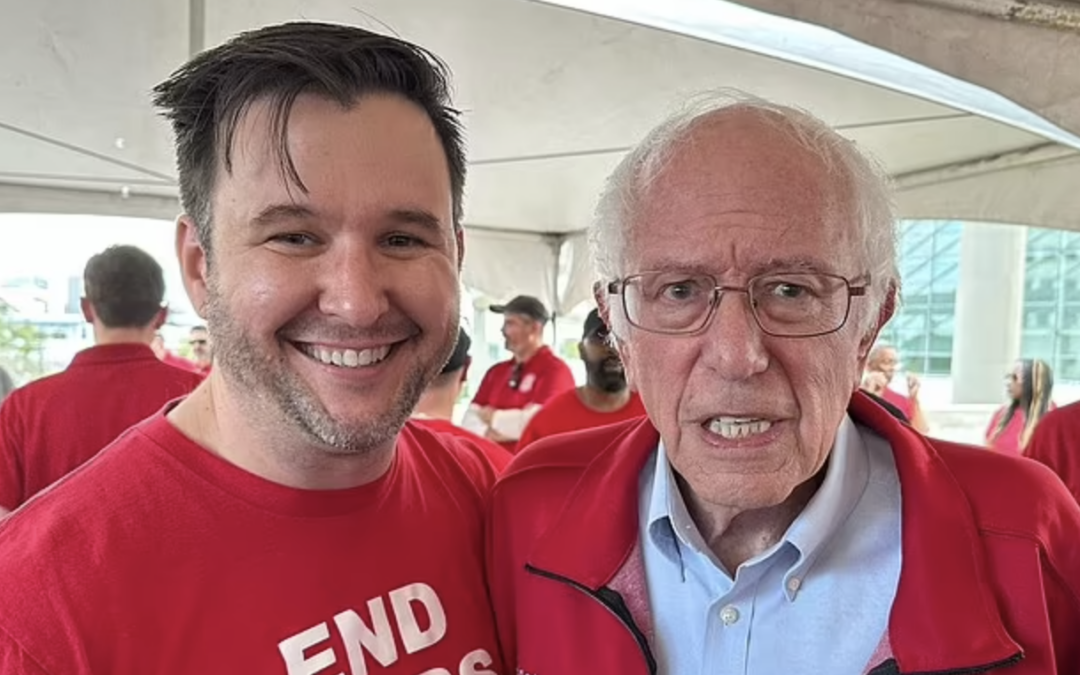These are heady times for the United Auto Workers.
The Detroit-based union in September took a huge risk by launching targeted strikes against production facilities of Ford, General Motors and Stellantis (formerly Chrysler). But the more than six-week walkouts brought the Big Three automakers to the bargaining table and settlements. The union won steep wage and benefit hikes, plus an end to a two-tiered wage scale created in 2007 in which new hires were paid far less than workers with seniority. In each case, workers voted by wide margins to ratify the pacts. Significantly, UAW President Shawn Fain, elected this March, along with his principal strategist and organizer, Chris Brooks, view capitalism as the enemy. As such, these victories may well reverberate beyond the auto industry.
Viewed solely in terms of membership, the UAW long has been in decline. For the last decade and a half, the union has averaged around 400,000 active members, way down from 1.5 million in the late 1970s. But reduced membership doesn’t necessarily mean reduced bargaining power. In fact, the union in this century has wrung a series of costly concessions from the Big Three automakers. And that heavily owes to the UAW’s cultivation of close ties to Congress and several administrations. The outcomes of lobbying during that crucial period of 2007-09 proved indispensable. In a real sense, it served as a backstory to the recent radical takeover.
Major automakers, particularly Chrysler and General Motors, were in financial peril by 2008. Soaring labor costs were a major reason. By the close of 2006, the average cost per assembly line worker, as calculated by the New York Times, had reached more than $70 an hour. Though wages were far from the whole package – health care, retirement and other benefits had risen dramatically – that did not negate the fact that employers could not keep up with the costs. Nor did it negate the fact that aside from issues over design and workmanship, these costs were far higher than those borne by foreign carmakers, particularly the Japanese. The pre-bankruptcy average labor cost for Chrysler, General Motors and Ford, respectively, were $75.86, $70.51 and $73.26 an hour. For Toyota, Honda and Nissan, the numbers were $47.60, $42.95 and $41.97 an hour. For all private U.S. manufacturing, the composite average was $29.89 an hour. Our auto workers were well paid.
UAW Gets Bailed Out
The Bush administration in 2007 already had engineered a labor cost bailout, persuading Chrysler, GM and the UAW to accept a two-tiered hourly wage system. New hires now would make only about $15 an hour, far below the $28 an hour for workers with seniority. It was a bitter pill for the United Auto Workers to swallow. But it did so, believing this was necessary to stave off Chapter 11 bankruptcies that likely would have resulted in court-ordered pay cuts anyway (as happened with the airlines). Even that measure, however, wasn’t enough. By the fall of 2008, with a recession in full swing, GM and Chrysler owed tens of billions of dollars to bondholders and suppliers, and tens of billions more to the UAW Retiree Medical Benefit Trust.
The lame duck Bush administration quickly devised an alternative to bankruptcy. Unveiled that December, the bailout plan would allow General Motors and Chrysler (Ford declined to participate) to draw a combined $17.4 billion in emergency short-term loans from the Treasury Department’s new, congressionally-authorized Troubled Asset Relief Program (TARP). A sum of $13.4 billion would come first, to be followed by another $4 billion in February. The government would have a binding stake in both companies. If GM and Chrysler failed to achieve “viability,” the government could call in the loans. Though TARP’s $700 billion authorization was geared toward financially troubled banks and insurance companies, the administration deemed the auto industry too crucial to the nation’s welfare to be resolved through Chapter 11.
Taxpayers Get Hosed
More than anything else, the bailout was a gift to the United Auto Workers. Bush’s successor, Barack Obama, dismissed the idea that this was payback to the unions, calling it “a load of you know what.” But everything smacked of favoritism. The administration cornered the two automakers into accepting a plan in which they would declare bankruptcy, re-charter themselves as new companies, and receive large sums of money. In return, the government would have large percentage equity stakes. The UAW emerged as the winners. Unlike other creditors, for example, the union would have the authority to recover most of its claims. And union workers (though not nonunion workers) at GM’s former auto parts subsidiary, Delphi, would have their underfunded pensions replenished. The giveaway to the unions was so blatant that even Obama’s “car czar,” Steven Rattner, later admitted, “We should have asked the UAW to do a bit more.”
Taxpayers bore a heavy price. According to an initial estimate by labor policy analysts Todd Zywicki and James Sherk, the out-of-pocket cost of the bailout, factoring in extra-legal costs, was $26.5 billion.
“None of that money was necessary to keep GM or Chrysler operating, to keep their suppliers in business, or to prevent layoffs,” wrote the authors. “The taxpayer losses came solely from propping up UAW pay and benefits.”
Later, in testimony in June 2013 before the House Committee on Oversight and Government Reform, Sherk noted, referring to separate studies by the Congressional Budget Office and the Treasury Department, that even assuming all the government loans are repaid, taxpayers would bear a cost of around $17 billion to $20 billion.
There is a larger point to recalling all this. During 2007-09, our government, working in tandem with the United Auto Workers, socialized the auto industry. As a result, Leftist zealots such as Shawn Fain and Chris Brooks had all the more motive to escalate demands in their organizing and representation efforts. Indeed, in any industry, socialism and socialists go together.
Organizing Failures
Following the bailout, the United Auto Workers ramped up their campaigns to unionize nonunion shops. These production facilities, typically located in in Right to Work southern states, were rip for organizing. UAW organizers went all out to win representation at the Volkswagen assembly plant in Chattanooga, Tenn. The campaign didn’t pan out. Workers in February 2014 rejected affiliation in a close 712-626 National Labor Relations Board-supervised vote. The union tried a second time in 2019, but lost again, though by an even closer 833-776. There were other disappointments. In a 2017 vote on whether to unionizing the Nissan facility in Canton, Miss., the UAW lost by 2,244-1,307. And after a long campaign to organize Mercedes-Benz assembly line workers in Vance, Alabama, the union threw in the towel without having been able to set up a vote.
It was another set of events that would undermine the credibility of Old School UAW leadership in the eyes of the radicals. In July 2017, following a four-year FBI probe, the Justice Department indicted several officials each of the UAW and Chrysler for bribery, embezzlement and tax evasion related to the misuse of millions of dollars of Chrysler training center funds. The charges led to a string of guilty pleas, eventually including from UAW President Gary Jones and his immediate predecessor, Dennis Williams. As part of the consent decree, a federal monitor would oversee union operations. Moreover, the union from now on would have to choose its leaders through direct elections.
These events gave radicals ever more impetus toward control of the union. Shawn Fain has benefited most. Now 55, Fain, a native of Kokomo, Ind., came from a UAW family; indeed, one of his grandfathers was hired by Chrysler in 1937, the year the union won recognition as a collective bargaining agent. He began as an electrician at the local Chrysler plant, eventually winning a promotion to shop foundry chairman. He then moved to Detroit to take a staff job at union headquarters to aid in contract negotiations. Increasingly active in UAW political affairs, he became convinced that the union would benefit from a more confrontational style of leadership and that he was the man to lead.
Autoworkers On-Campus?
The union by 2023 had witnessed a rapid succession of presidents – Bob King, Dennis Williams, Gary Jones, Rory Gamble and Ray Curry. A growing number of workers had come to believe, rightly or wrongly, that extreme steps were necessary to achieve stability and strong contracts. Fain barnstormed for the international presidency. And he had plenty of supporters, in no small measure due to the fact that about a third of the union’s active members now consisted of university post-doctorate or graduate student employees. A recent strike showed that they could deliver the goods. The 40-day UAW walkout in 2019 against General Motors had cost the automaker between $2 billion and $4 billion in revenues, resulting in a settlement that, among other things, would lessen the time needed for a new worker to reach a full hourly wage. He and the other candidates who comprised the Members United slate vowed to take off their gloves. Their slogan: “No corruption, no concessions, no tiers.”
Fain would be elected by a razor-thin margin on March 25, 2023 in a runoff against incumbent Ray Curry. His victory speech hit the right notes on corruption:
For too long, this union has been divided. We’ve been divided by corruption and self-serving leadership at the top. The UAW once set the standard for what a clean, progressive, member-led union looks like. But the last few decades have seen us veer far off course. UAW officers, the people elected to lead and serve this great union, have taken bribes, stolen dues, and betrayed the trust of the membership. That ends here.
Fain’s Marxist Agiprop
Fain, a close friend of Sen. Bernie Sanders, I-Vt., unleashed his turbo-charged socialist populism the next day. “We are united to serve you,” he declared. “Now, we’re here to come together to ready ourselves for the war against our one and only true enemy: multibillion dollar corporations and employers that refuse to give our members their fair share.” Months later, he blasted away at rich individuals. “Billionaires, in my opinion, don’t have a right to exist,” he remarked in September. Joining worker picket lines this fall, he often sported a T-shirt that read “Eat the Rich.” And in a video presentation during the strike, he declared:
The Big Three want you to believe that what we are asking for is dangerous and unrealistic. What is truly unrealistic is to keep making record profits year after year and then think that the workers who made those profits are just going to settle for scraps. What is truly dangerous is for corporations and the billionaire class to continue making out like bandits while the working class gets left further and further behind.
The people in charge of the United Auto Workers are radicals, not liberals. To them, automakers aren’t so much adversaries as enemies. The strike against the Big Three automakers, which began just after midnight on September 15 shortly after the expiration of the previous contract, could have been predicted. And it paid off. Auto manufacturers, reeling from rising interest rates and disappointing sales, acceded to crucial union demands.
At Ford, workers on November 17 approved a pact that raised the top wage by over 30 percent to more than $40 an hour; restored cost-of-living adjustments (COLAs); ended seniority-based tiered wage rates, with starting workers getting a pay raise of almost 70 percent; and expanded member pension and 401(k) retirement benefits. President Fain and Vice President Chuck Browning gave these specifics in a web posting:
Lower-tiered members at Sterling Axle (in Sterling Heights) and Rawsonville (in Ypsilanti) will see immediate raises ranging from 53% to 88%. A member with three years’ seniority at those facilities will, upon ratification, go from $18.96 to $35.58. With COLA, by 2028, we’ll have a top rate over $42 an hour for production, and over $50 for skilled trades, an over 30% raise. By the end of this agreement, our starting rate will be pushing $30 an hour with COLA.
At General Motors and Stellantis, the UAW likewise won generous COLA adjustments and enhanced pension fund contributions. The Stellantis deal also contained an agreement that would force the company to reopen a plant in Belvidere, Ill. that had been closed in February and to keep facilities open in Toledo, Ohio and Trenton (suburban Detroit), Mich. All three deals contained a provision that guaranteed the union’s right to strike in the event that any plant is closed during the new contract period.
The union won this round. And Shawn Fain is sitting pretty. He’s assembled an aggressive leadership team whose de facto leader is a Brooklyn, N.Y.-based labor affairs writer and UAW consultant Donald Christopher (“Chris”) Brooks, (in photo with Bernie Sanders) Now in his mid-30s, Brooks in the middle of the last decade had worked in Chattanooga as a full-time union organizer for the Tennessee Education Association (TEA), the state affiliate of the National Education Association. He also served as a community organizer for area progressive evangelical Christian churches and wrote a master’s thesis on the failed UAW campaign in Chattanooga. When Fain ran for UAW president, Brooks played a key role in corralling support from university graduate students and post-doctoral fellows.
Master’s Thesis Marxist
Brooks has never worked at an auto assembly plant. Indeed, while in Chattanooga he triggered numerous complaints from union organizers about his interference in the 2013-14 Volkswagen campaign. Brooks had urged VW workers to form an independent union rather than stick with the UAW. In May 2014, then-United Auto Workers President Bob King sent a letter to the TEA, requesting that it tell Brooks to stop interfering with the union’s organizing. Sensing his time in Chattanooga was up, Brooks landed a job as a staff writer for the pro-union Labor Notes. His dispatches led to his being hired in 2020 as field director for the 3,000-member, UAW-affiliated New York Media Guild. In essence, Chris Brooks is more of a blogger/social media influencer than he is a union man.
Chris Brooks’ organizational style has cost several of Shawn Fain’s hand-picked people their jobs. Weeks before the announcement of his election victory, Fain fired most of his top staffers. One of them, Joe Rioux, pointed the finger at Brooks. In a memo to Fain dated February 22, 2023, Rioux wrote:
My concerns and the concerns shared by the team members listed above are that Chris has assumed a role in the transition and in your future administration that he does not possess the experience or personal maturity to carry out. In a short time, his lack of transparency, his need for control over departmental discussions, his need to control access to you, and his apparent lack of ability to work in a real collaborative manner became apparent.
Fain never responded. Chris Brooks is Shawn Fain’s right-hand man, an ideologue on a mission far larger than unionism. While some objections about Brooks’ behavior have come from black assembly line workers demanding more attention to racial “diversity” (i.e., affirmative action), the fact remains that his rather minimal attention to issues raised by assembly line workers is an extension of his “change the world” utopianism. Those beliefs pretty much amount to what most people would call communism. He wouldn’t object to the label either.
A member of the far-Left Democratic Socialists of America (DSA), Brooks rarely wastes an opportunity to point out capitalism’s ostensible failures. Facts here take a back seat to raw emotions. Interviewing New York City teachers and health care professionals, he claimed that the COVID-19 crisis was the result of corporate greed and waste. “The number of children hospitalized with COVID has hit an all-time high nationally,” he wrote. “During all of that, the rich have only gotten richer. On the same day that a new national record for COVID cases was set, Wall Street hit a record high.” In a related outlandish claim, during his interview of New Left gray eminence Noam Chomsky, Brooks asserted that corporate leaders conspired to make the pandemic “worse, for their benefit” and that “institutional racism” was responsible for the “disproportionate impact” on persons of color.
There’s more. In July 2018, Brooks submitted a Freedom of Information Act request to the FBI for “any and all file records” concerning mention of the DSA, insisting that such records should be made publicly available. Two months later, the FBI sent Brooks 11 separate case files dating back to the 1970s and 80s. And unrelated to this, in 2021 he tweeted his enthusiasm over a new book, A People’s Guide to Capitalism: An Introduction to Marxist Economics. The author, journalist and fellow DSA member Hadas Thier, explicitly modeled the book on Karl Marx’s Das Kapital.
It takes no great stretch of the imagination to figure out why around one-third of all active United Auto Workers members now consist of university postdoctoral and graduate student employees. Chris Brooks and Shawn Fain speak their language.
UAW Targets Nonunion Plants
Shawn Fain, Chris Brooks and their allies are readying themselves for unionizing 13 nonunion assembly plants, 10 of them foreign-owned and three domestically-owned. The initial target is an old haunt: the Volkswagen plant in Chattanooga, the maker of the electric VW ID.4 and the family of combustion-engine Atlas SUVs. The factory now employs around 3,800 workers. It is possible that the union will get a third shot at an election, having already secured signed pledge cards from over 1,000 workers. VW, not taking any chances, gave workers an 11 percent raise shortly after the Big Three contract settlements. The UAW also seeks to organize facilities of BMW, Honda, Hyundai, Mazda, Mercedes, Nissan, Subaru, Toyota and Volvo, along with plants of the U.S.-based Tesla, Lucid and Rivian, makers of electric cars.
On January 4, thirty-three U.S. Senators wrote the CEOs of the nonunion companies demanding that they implement a “neutrality agreement” in their plants. In other words, significant political pressure is being applied to the companies to surrender to the UAW organizing campaign.
If Fain, Brooks and company can pull off a large number of wins, a clear path to AFL-CIO leadership may await them. That prospect should scare more than a few of us.









